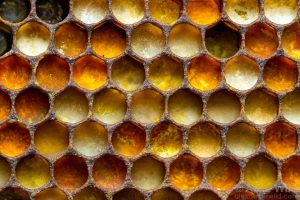Bees are not the first or only insects to pollinate flowers, but they did evolve to become one of the most efficient in this task. Bees pollinate flowers accidentally as they fly to different flowers collecting pollen to take back to their hive.
For flowers, there are two types of pollination, self-pollination, and cross-pollination. Bees can help both processes by simply going about their pollen collection routine.
In self-pollination, a bee can help by moving pollen grains from the anther of the flower directly onto the stigma of the same flower. They do this by walking around on the flower in their search for pollen.
For cross-pollination, the bee helps flowers by transferring the pollen from the anther of one flower to the stigma of a different flower. They do this by flying from one flower to the next. As a bee can fly to multiple flowers collecting pollen in the same trip, they’re rather effective in assisting in this process.
How do flowers attract bees?
Scientists believe that modern bees evolved from wasps which were predators of other insects, and that the switch from prey to pollen may have occurred when the larvae of their ancient ancestors would consume flower dwelling insects that were covered with pollen.
Nectar, a sugary sweet liquid, is often made by flowers as a lure to get an insect, or other creatures, to the flower to help move pollen from one flower to another.
While honeybees have evolved in such a way that they search for both pollen and nectar, something like a Hummingbird would only be out searching for nectar. As a result of these nectar seeking creatures, flowers developed delicious nectar’s which would be buried deep down inside the flower in long tubes. So, while the insect or bird searched deep into the flower for the nectar, they’d inadvertently get pollen on themselves, and then transfer that pollen to other flowers they’d then land on.

Honeybees evolved right along with flowers, developing longer tongues to extract the nectar more efficiently, as well as grow scopa hairs (think Velcro) and pollen baskets on their hind legs to help collect and carry pollen.
In an act that further assists the pollination process, bees will perform what is known as a waggle dance to communicate the location of a food source to other worker bees. This means that flowers will continue to see visitors if a bee likes what she finds.
Here’s a great video on the “Waggle Dance”.
Why do bees collect pollen?
A lot of people get confused between pollen and nectar. Bees gather both pollen and nectar, but for different reasons.
Both pollen and nectar are collected by bees to be used as food. At a basic level, pollen provides the bees protein, and nectar, which bees turn into honey, provides carbohydrates.

Nectar, which bees convert into honey, is the main source of carbohydrates for the bees. Nectar is also a source of various minerals beneficial for the bees, although the presence and amount of minerals will depend on the nectars source. They use the energy gained from these carbohydrates for flying, hive maintenance, and other daily chores.
Without an adequate supply of carbohydrates, a colony of bees can die out rather quickly, which is one of the reasons beekeepers need to pay close attention to honey stores going into wintertime, when collecting nectar becomes almost impossible in most regions.
Pollen, which bees turn into “bee bread” is the honeybee’s main source of proteins, fats, and vitamins. The protein that pollen provides is vital to brood production and the growth of new bees. It’s worth noting that not all pollen is equally nutritious for bees, and this is one of the many reasons bees need access to a variety of plants and flowers.
How do bees store pollen?
When bees get this packed pollen into the hive, they need to store it in such a way that It’ll keep well and can be consumed. Honeybees do this by inserting some pollen into a cell along with some honey or nectar and some enzymes secreted by the bees themselves. This stored pollen is what is called “bee bread”. This “bee bread” provides an excellent source of protein for growing bees and worker bees alike.

Some beekeepers choose to collect pollen using something called a pollen trap.
Pollen traps make bees enter the hive through a narrow opening in order to move up into the hive, which causes some of the pollen they’re carrying to get stripped off their legs. The pollen then falls into a collection drawer at the base of the hive.

The granules you can see in the pollen drawer here is raw pollen that bees have packed onto their legs. Once the pollen is collected, beekeepers can then sell it, eat it, or use it for bee feed. Using a pollen trap is also a really great way to figure out what plants your bees are visiting. With a glance you can get an understanding of the variety of food sources your bees have access to by noting the different shades of pollen present in the drawer.
To learn more about bees, (including if they’ll remember your face!) check out our “All About Bees” section.


![3 Big Mistakes Beginner Beekeepers Make [And How To Avoid Them!]](https://beekeepingabc.com/wp-content/uploads/2020/11/3-mistakes-beginner-beekeepers-make-90x75.jpg)

![Move over ducks, Queen Bees quack too! [Here’s Why]](https://beekeepingabc.com/wp-content/uploads/2020/06/queen-bee-90x75.png)
![The Flow Hive 2 Review [ Vs. The Classic Flow Hive]](https://beekeepingabc.com/wp-content/uploads/2020/02/Flow-Hive-2-90x75.jpg)
![How Bees Fly [10 Facts About How, When, and Why]](https://beekeepingabc.com/wp-content/uploads/2019/12/A-Bee-Flying-90x75.jpg)